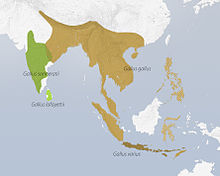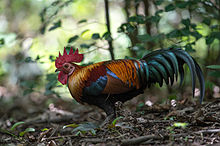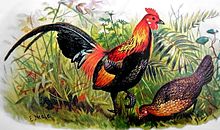Red junglefowl
| Red junglefowl | |
|---|---|

| |
| Male red junglefowl | |
| Scientific classification | |
| Domain: | Eukaryota |
| Kingdom: | Animalia |
| Phylum: | Chordata |
| Class: | Aves |
| Order: | Galliformes |
| Family: | Phasianidae |
| Genus: | Gallus |
| Species: | G. gallus
|
| Binomial name | |
| Gallus gallus | |

| |
| Red junglefowl (Brown) | |
| Synonyms | |
|
Phasianus gallus Linnaeus, 1758 | |
The red junglefowl (Gallus gallus) is a
Evidence from the molecular level derived from whole-genome sequencing revealed that the chicken was domesticated from red junglefowl about 8,000 years ago,[2] with this domestication event involving multiple maternal origins.[2][4] Since then, their domestic form has spread around the world where they are kept by humans for their meat, eggs, and companionship.[5]
Taxonomy and systematics
The red jungle fowl has 5 recognized subspecies:[6]
- G. g. bankiva (Temminck, 1813) - Java and Bali
- G. g. gallus (Linnaeus, 1758) - southern Myanmar through Indochina
- G. g. jabouillei (Delacour & Kinnear, 1928) - south China to northern Vietnam and northern Laos
- G. g. murghi (Robinson & Kloss, 1920) - north India, Nepal, Bhutan, and Bangladesh
- G. g. spadiceus (Bonnaterre, 1792) - northeastern India to south China, the Malay peninsula, and north Sumatra
| |||||||||||||||||||||
| Cladogram showing the species in the genus Gallus.[2][7] |
Description
The
Compared to the more familiar domestic chicken, the red junglefowl has a much smaller body mass (around 2+1⁄4 lbs (1 kg) in females and 3+1⁄4 lbs (1.5 kg) in males) and is brighter in coloration.[8] Junglefowl are also behaviourally different from domestic chickens, being naturally very shy of humans compared to the much tamer domesticated subspecies.
Sexual dimorphism
Male junglefowl are significantly larger than females and have brightly coloured decorative feathers. The male's tail is composed of long, arching feathers that initially look black, but shimmer with blue, purple, and green in direct light. He also has long, golden hackle feathers on his neck and his back. The female's plumage is typical of this family of birds in being cryptic and adapted for camouflage. She alone looks after the eggs and chicks. She also has a very small comb and wattles (fleshy ornaments on the head that signal good health to rivals and potential mates) compared to the males.

During their mating season, the male birds announce their presence with the well-known "cock-a-doodle-doo" call or
Genetics
Orthology
G. gallus has three transferrins, all of which cluster closely with other vertebrates' orthologs.[13]
Distribution and habitat
The range of the wild form stretches from
Red junglefowl prefer disturbed habitats and edges, both natural and human-created. The forage
Red junglefowl drink surface water when it is available, but they do not require it. Birds in North-Central India visit water holes frequently during the dry season, although not all junglefowl on the subcontinent live close enough to water to do so;[17] population densities may thus be lower, where surface water is limited.[16]
Behaviour and ecology

Red junglefowl regularly bathe in dust to keep the right balance of oil in their plumage. The dust absorbs extra oil and subsequently falls off.[23]
Flight in these birds is almost purely confined to reaching their roosting areas at sunset in trees or any other high and relatively safe places free from ground predators, and for escape from immediate danger through the day.[24]
Dominant male junglefowl appear to defend a territory against other dominant males, and the size of the territories has been inferred based on the proximity of roosts. Beebe[19] concluded that territories were rather small, especially as compared to some of the pheasants with which he was familiar. This was supported by Collias and Collias,[17] who reported that adjacent roost sites can be as close as 100 metres (330 ft). Within flocks, male red junglefowl exhibit dominance hierarchies, and dominant males tend to have larger combs than subordinate males.[25] Red junglefowl typically live in flocks of one to a few males and several females. Males are more likely to occur alone than females.[10][16][17][26][27][28]

Breeding
Males make a food-related display called "tidbitting", performed upon finding food in the presence of a female.[29] The display is composed of coaxing, cluck-like calls, and eye-catching bobbing and twitching motions of the head and neck. During the performance, the male repeatedly picks up and drops the food item with his beak. The display usually ends when the hen takes the food item either from the ground or directly from the male's beak. Eventually, they sometimes mate.[30]
In many areas, red junglefowl breed during the dry portion of the year, typically winter or spring. This is true in parts of India, Nepal, Thailand, Vietnam, and Laos.[10][16][17][26][27][28] However, year-round breeding by red junglefowl has been documented in palm oil plantations in Malaysia[21] and also may occur elsewhere.[27] During the laying period, red junglefowl females lay an egg every day. Eggs take 21 days to develop. Chicks fledge in about 4 to 5 weeks, and at 12 weeks old they are chased out of the group by their mother — at which point they start a new group or join an existing one. Sexual maturity is reached at 5 months, with females taking slightly longer than males to reach maturity.[8]
Dominant males attempt to maintain exclusive reproductive access to females, though females choose to mate with subordinate males about 40% of the time in a free-ranging feral flock in San Diego, California.[31][32]
Diet
Red junglefowl are attracted to areas with ripe fruit or seeds,[17] including fruit plantations,[20] fields of domestic grain,[19] and stands of bamboo.[10] Although junglefowl typically eat fallen fruits and seeds on the ground, they occasionally forage in trees by perching on branches and feeding on hanging fruit.[10] Fruits and seeds of scores of plant species have been identified from junglefowl crops, along with grasses, leaves, roots, and tubers.[10][33] In addition, red junglefowl capture a wide variety of arthropods, other invertebrates, and vertebrates such as small lizards. Even mammalian faeces may be consumed.[10] Many of these items are taken opportunistically as the birds forage, although some arthropods, such as termites, are taken in large quantities; about 1,000 individual termites have been found in a single crop.[10][17] Plant materials constitute a higher proportion of the diet of adult red junglefowl than do arthropods and other animals. In contrast, chicks eat mostly adult and larval insects, earthworms, and only occasional plant material.[10]
Relationship to humans
Timeline of domestication
In 2012, a study examined
Other archaeological evidence suggests domestication dates around 7,400 BP from the Chishan site, in the
| NCBI genome ID | 111 |
|---|---|
| Ploidy | diploid |
| Number of chromosomes | 78 |
| Year of completion | 2012 |
Hybridization
The other three members of the genus —
Conservation status
This section needs expansion. You can help by adding to it. (May 2021) |
Wild-type red junglefowl are thought to be facing threats due to hybridisation at forest edges, where domesticated free-ranging chickens are common.[37][38][39][40][41][42][43][44][45][46][47] Nevertheless, they are classified by the IUCN as a species of least concern.
References
- . Retrieved 19 November 2021.
- ^ PMID 32050971.
- ^ PMID 18454198
- PMID 16275023.
- ^ PMID 22848352.
- .
- .
- ^ a b c d Gautier, Zoe. "Gallus gallus (red junglefowl)". Animal Diversity Web. Retrieved 2 March 2019.
- ^ a b Wild Singapore: Red Junglefowl, updated 9 October, accessed 1 January 2014.
- ^ a b c d e f g h i j k Collias, N. E., N. E.; Saichuae, P. (1967). "Ecology of the red jungle fowl in Thailand and Malaya with reference to the origin of domestication" (PDF). Natural History Bulletin of the Siam Society. 22: 189–209.
- JSTOR 1368641
- S2CID 53197810
- PMID 23552219.
- ISBN 9781760460945.
- ^ Bump, G.; Bohl (1961). "Red Junglefowl and Kalij Pheasants". US Fish and Wildlife Service, Washington D.C., Special Scientific Reports, Wildlife (62).
- ^ a b c d e Johnson, R. A. (1963). "Habitat preferences and behavior of breeding jungle fowl in central western Thailand". Wilson Bulletin. 75: 270–272.
- ^ JSTOR 1366199.
- ^ a b Datta, A. (2000). "Pheasant abundance in selectively logged and unlogged forests of western Arunachal Pradesh, Northeast India". Journal of the Bombay Natural History Society. 97: 177–183.
- ^ a b c Beebe, W. (1921). A monograph of the Pheasants. London: Witherby & Co.
- ^ a b c Abdullah, Z.; Babjee, S. A. (1982). "Habitat preference of the Red Junglefowl (Gallus gallus)". Malaysian Applied Biology. 11: 59–63.
- ^ a b Arshad, Z.; Zakaria, M. (1999). "Breeding ecology of red junglefowl (Gallus gallus spadiceus) in Malaysia". Malayan Nature Journal. 53: 355–365.
- ^ Arshad, Z.; Zakaria, M.; Sajap, A. S.; Ismail, A. (2001). "Roosting ecology of red jungle fowl (Gallus gallus spadiceus) in oil palm plantation". Pakistan Journal of Scientific and Industrial Research. 44: 347–350.
- ^ Brinkley, Edward S., and Jane Beatson. "Fascinating Feathers ." Birds. Pleasantville, N.Y.: Reader's Digest Children's Books, 2000. 15. Print.
- ^ "Red Junglefowl, Gallus gallus | Beauty of Birds". 16 September 2021.
- S2CID 53149022.
- ^ .
- ^ .
- ^ .
- ^ Animal Behaviour Lab Dr Chris Evans, Galliform.bhs.mq.edu.au, 15 November 2006, archived from the original on 2 May 2009, retrieved 22 April 2009
- ^ Home, Galliform.bhs.mq.edu.au, archived from the original on 11 December 2008, retrieved 22 April 2009
- S2CID 53170763.
- PMID 6008475.
- ^ "Gallus gallus (Red junglefowl)". Animal Diversity Web.
- ^ PMID 25886773.
- ^ PMID 25795243.
- JSTOR 3623329.
- ^ I. Lehr Brisbin Jr., Concerns for the genetic integrity and conservation status of the red junglefowl, FeatherSite, retrieved 19 September 2007
- ^ Society for the Preservation of Poultry Antiquities, archived from the original on 18 September 2007
- ^ Red Junglefowl (Gallus gallus) page & links
- ^ Tomas P. Condon, Morphological and Behavioral Characteristics of Genetically Pure Indian Red Junglefowl, Gallus gallus murghi, archived from the original on 29 June 2007, retrieved 19 September 2007
- ^ Hawkins, W.P. (n.d.). Carolinas/Virginia Pheasant & Waterfowl Society. Red Junglefowl – Pure Strain, Cvpws.com, retrieved 19 September 2007
- ^ Gautier, Z. 2002. Gallus gallus (On-line), Animal Diversity Web. Accessed 19 September 2007, Animaldiversity.ummz.umich.edu, retrieved 22 April 2009
- ^ Genetic invasion threatens red jungle fowl, Wildlife Trust of India, New Delhi, 9 January 2006, archived from the original on 5 November 2007, retrieved 19 September 2007
- ^ "Red Junglefowl genetically swamped", Tragopan No. 12, P. 10, World Birdwatch 22 (2), 1 June 2000, retrieved 19 September 2007,
According to some scientists, truly wild populations of the red junglefowl Gallus gallus are either extinct or in grave danger of extinction due to introgression of genes from domestic or feral chickens
- ^ "Red Junglefowl – Species factsheet: Gallus gallus", BirdLife Species Factsheet, BirdLife International, 2007, retrieved 20 September 2007
- hdl:1808/6522
- ^ Brisbin, I. L. Jr. (1969), "Behavioral differentiation of wildness in two strains of Red Junglefowl (abstract)", Am. Zool., 9: 1072
External links
- Malaysian Red Junglefowl
- Red Junglefowl: Pure-bred v/s Cross-bred
- ARKive – images and movies of the Red Junglefowl (Gallus gallus)
- BirdLife Species Factsheet
- Red Junglefowl
- View the red junglefowl genome in Ensembl
- View the galGal4 genome assembly in the UCSC Genome Browser.
- Gallus bankiva (illustration) in Sir William Jardine, The natural history of gallinaceous birds: Vol. I., published by W. H. Lizars, and Stirling and Kenney, 1834; at Google Books.
- Reference guide to the four species of the genus Gallus, commonly known as junglefowl. Contains information and photographs of each of the species
- Ancestors of chickens studied for conservation; 7 August 2008; The Economic Times, Times of India

